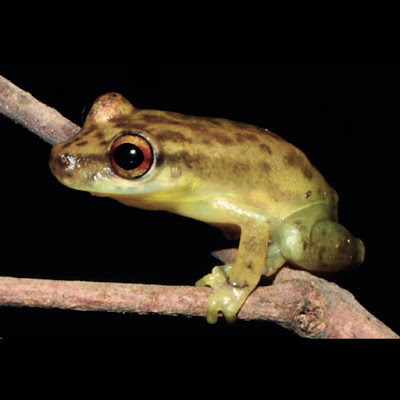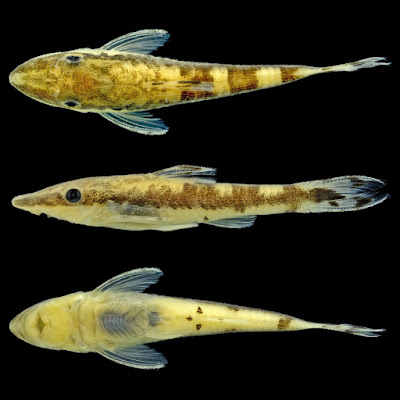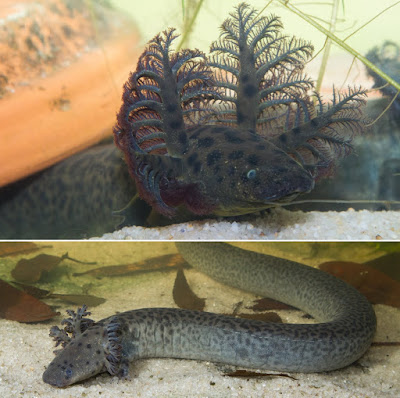[Most Recent Entries] [Calendar View]
Thursday, December 6th, 2018
| Time | Event | ||||
| 12:51p | [Herpetology • 2018] Cenaspis aenigma • Caudals and Calyces: The Curious Case of a Consumed Chiapan Colubroid
Abstract A new genus and species of colubroid snake is described from the isolated highlands of western Chiapas. This enigmatic little snake possesses a unique suite of characters that defies placing it in any known genus and clearly distinguishes it from all known genera. Several of the most unusual features include subcaudals undivided throughout the length of the tail and a simple hemipenis completely adorned with calyces and having a sulcus spermaticus that remains unbifurcated until the apical portion of the organ. Neither of these characteristics is known for any other colubroid of the Western Hemisphere. Consideration of morphology places the new snake in the Dipsadidae and suggests that Adelphicos, Atractus, Geophis, and Chapinophis are among its closest relatives.
Cenaspis, new genus Etymology.— The generic name is derived from the Latin cena, meaning dinner, and aspis, meaning a kind of snake, in reference to predation on the single known individual of this snake. The name taken literally means ‘‘dinner snake.’’ Cenaspis aenigma, new species Etymology.— From the Latin aenigma meaning a riddle or mystery. Jonathan A. Campbell, Eric N. Smith and Alexander S. Hall. 2018. Caudals and Calyces: The Curious Case of a Consumed Chiapan Colubroid. Journal of Herpetology. 52(4); 459-472. DOI: 10.1670/18-042 Resumen: Se describe un nuevo género y especie de serpiente colubrina de las montañas aisladas del oeste de Chiapas. Esta enigmática y pequeña serpiente posee un conjunto único de caracteres que impide su asignación a cualquier otro género y claramente la distingue de cualquier género conocido. Varios de las características inusuales incluyen subcaudales no divididas a lo largo de toda la cola y un hemipene simple, completamente cubierto de cálices, y con un surco espermático que permanece no bifurcado hasta el ápice del órgano. Ninguna de estas características es conocida de cualquier colúbrido en el hemisferio occidental. Examen de morfología sugiere que la nueva serpiente pertenece a la familia Dipsadidae y su afinidad esta con Adelphicos, Atractus, Geophis, y Chapinophis. | ||||
| 1:10p | [Herpetology • 2018] Scinax strussmannae • A New Species of Scinax (Anura: Hylidae) with Red-Striped Eyes from Brazilian Amazonia
Abstract We describe a new small species of Scinax from the rain forests on the interfluve between Purus and Madeira Rivers, Brazilian Amazonia. The new species is diagnosed by snout–vent length 20.2−22.5 mm in males; a yellowish-bronze dorsum showing small spots along the body and limbs; a red stripe horizontally extended on the medial portion of the iris; posterior surface of thigh brown, in both live and preserved specimens. The advertisement call consists of two types: type A represents a series of multipulsed notes (note duration 0.097−0.115 sec, dominant frequency 2,541−3,015 Hz); type B consists of a single tonal note (note duration 0.015–0.019 sec, dominant frequency 2,584–2,950 Hz).
Scinax strussmannae sp. nov. Etymology.— The specific epithet honors Christine Strüssmann for her friendship and outstanding contribution to Brazilian herpetology. Suggested Common English Name.— Strüssmann’s Snouted Treefrogs. Miquéias Ferrão, Jiří Moravec, Igor Luis Kaefer, Rafael de Fraga and Albertina Pimentel Lima. 2018. New Species of Scinax (Anura: Hylidae) with Red-Striped Eyes from Brazilian Amazonia. Journal of Herpetology. 52(4); 473–486. DOI: 10.1670/17-165 | ||||
| 1:38p | [Herpetology • 2018] Apostolepis adhara • A New Species of Apostolepis (Serpentes, Dipsadidae, Elapomorphini) from the Cerrado of Central Brazil
Abstract We describe a new species of the genus Apostolepis found near São Salvador Hydroelectric Power Plant, municipality of São Salvador do Tocantins, in the central Cerrado ecoregion. The new species is distinguished from its congeners by the following combination of characters: presence of eleven dorsolateral stripes, five infralabial scales and the lack of preoculars scales. The new species shares some external characteristics mainly with A. arenaria, A. gaboi and A. nelsonjorgei, with which it is compared. Keywords: Reptilia, Apostolepis arenaria, A. gaboi, A. nelsonjorgei, Color pattern, Pholidosis, Skull osteology, Taxonomy Apostolepis adhara sp. nov. Etymology. The specific epithet “adhara” refers to the name of the star Epsilon Canis Majoris (ε CMa), from the constellation of Canis Major, which means “maidens” or "(the) virgins" in Arabic (Al ʽAdhārā) (Allen 1963). In the Brazilian flag, this star represents the state of Tocantins. Curiously, Adhara is the second brightest star of its constellation, as well as the Cerrado, corresponds to the second largest biome in South America. We suggest the vernacular name "São Salvador burrow-snake". Daniella França, Fausto E. Barbo, Nelson J. Silva-Júnior, Helder L. R. Silva and Hussam Zaher. 2018. A New Species of Apostolepis (Serpentes, Dipsadidae, Elapomorphini) from the Cerrado of Central Brazil. Zootaxa. 4521(4); 438–552. DOI: 10.11646/zootaxa.4521.4.3 Resumo: Descrevemos uma nova espécie do gênero Apostolepis, encontrada próxima à Hidrelétrica de São Salvador, Município de São Salvador do Tocantins, no centro da Ecoregião Cerrado. A nova espécie distingue-se de seus congêneres pelas seguinte combinação de caracteres: presença de onze estrias dorsolaterais, cinco escamas infralabiais e ausência das escamas preoculares. A espécie nova compartilha algumas características externas principalmente com A. arenaria, A. gaboi e A. nelsonjorgei, com as quais é detalhadamente comparada. Palavras-chave: Apostolepis arenaria, A. gaboi, A. nelsonjorgei, folidose, padrão de coloração, taxonomia  | ||||
| 1:50p | [Ichthyology • 2018] Curculionichthys scaius • A New Species of Curculionichthys (Siluriformes: Hypoptopomatinae) from the Western Border of the Brazilian Shield, Madeira River Basin, Brazil
Curculionichthys scaius, new species, is distinguished from other congeners by having two usually conspicuous, somewhat triangular dark brown speckles lateral to the anal-fin origin, a pointed snout with paired rostral plates, numerous lateral abdominal plates, a single series of large median abdominal plates, numerous dentary and premaxillary teeth, and several morphometric proportions of the body and head, mostly involving prepelvic, prepectoral, and preanal distances, head and cleithral width, caudal peduncle length, and dorsal-fin spine. The new species represents the first record of the genus Curculionichthys in the Madeira River basin and is the most westerly distribution in the Amazon.
Curculionichthys scaius, new species Etymology.— The specific epithet scaius, from the Greek Rjaior (skaios), meaning west, westward, in allusion to the westerly distribution in the Brazilian Shield. An adjective. Bárbara B. Calegari, Suelen P. Gamarra, and Roberto E. Reis. 2018. A New Species of Curculionichthys (Siluriformes: Hypoptopomatinae) from the Western Border of the Brazilian Shield, Madeira River Basin, Brazil. Copeia. 106(4); 663-670. DOI: 10.1643/CI-18-133 Curculionichthys scaius, espécies nova, é distinguida dos demais congêneres por possuir um par de pequenas manchas escuras triangulares laterais à origem da nadadeira anal, margem anterior do focinho pontiaguda com uma placa rostral pareada, numerosas placas abdominais laterais, uma série única de grandes placas medianas abdominais, numerosos dentes no dentário e pré-maxila, e diversas proporções morfométricas do corpo e da cabeça, a maioria envolvendo as distâncias pré-pélvica, pré-peitoral, e pré-anal, a largura da cabeça e do cleitro, o comprimento do pedúnculo caudal, e o espinho da nadadeira dorsal. Esta nova espécie representa o primeiro registro do gênero Curculionichthys para a bacia do Rio Madeira, sendo a espécie com distribuição mais a oeste na bacia Amazônica. | ||||
| 3:01p | [Herpetology • 2018] Siren reticulata • Description of An Extant Salamander (Caudata: Sirenidae) from the Gulf Coastal Plain of North America: The Reticulated Siren
Abstract The salamander family Sirenidae is represented by four extant species that are restricted to North America. Sirens are abundant throughout the southern United States and are among the world’s largest amphibians, yet the biology, ecology, and phylogeography of this group is poorly-known. In this study we use morphological and genetic evidence to describe a previously unrecognized species from southern Alabama and the Florida panhandle. We name this species the Reticulated Siren, Siren reticulata. Future studies will enable more precise phylogenetic information about S. reticulata and will almost surely reveal additional undescribed species within the family. Siren reticulata, sp. nov. Reticulated Siren Etymology: This animal has been colloquially referred to as the Leopard Eel. However, given that the species is neither a leopard nor an eel, we selected Reticulated Siren as a more appropriate formal common name. The specific name, reticulata, is a reference to the reticulated pattern typical of all specimens we examined. Diagnosis: Like all Sirenids, S. reticulata has an elongate, eel-like body shape, two forelimbs, no eyelids, a lateral line, enlarged external gill fimbriae associated with gill slits, and a horny beak in place of the premaxillary teeth typical of other salamanders. There are only two known genera in the family Sirenidae: Pseudobranchus and Siren. The genus Pseudobranchus (dwarf sirens) includes two species (restricted to Florida, southern Georgia, and South Carolina) and is diagnosed by the presence of only one gill slit and three digits on each limb. The species we describe herein is assigned to the genus Siren based upon its large size, presence of four digits on the forelimbs, and three permanent gill fimbriae with three associated external gill slits. The dorsum of S. reticulata is olive-grey with lighter yellow-green flanks. It has an obvious and striking dark reticulate spotted pattern beginning at the gill arches and continuing to the tail (Fig 1A). Some specimens show a decided boundary where the spotting pattern ends along the flanks, while others show continuous spotting along the flanks that continue onto the ventral surface. The venter is a lighter olive green-yellowish color and in some specimens, it is also sparsely covered with irregular spots. ..... Life history and ecology: Due to the difficulty in acquiring specimens and this species’ apparently limited distribution, little is known of S. reticulata life history and ecology. Clearly, research on this topic is an urgent need. Most of what we know of this species is consistent with the general habits of other described species of sirens. The holotype contains hundreds of tiny developing follicles, suggesting that females have high fecundity, a feature also exhibited by S. lacertina. Mating, fertilization mode (e.g., external or internal), nests, and eggs are undescribed. However, we emphasize that this information is scarce even for long-recognized S. lacertina or S. intermedia. Sean P. Graham, Richard Kline, David A. Steen and Crystal Kelehear. 2018. Description of An Extant Salamander from the Gulf Coastal Plain of North America: The Reticulated Siren, Siren reticulata. PLoS ONE. 13(12): e0207460. DOI: 10.1371/journal.pone.0207460 New species of giant salamander discovered in Florida on.natgeo.com/2E4tI2n via @NatGeo |
| << Previous Day |
2018/12/06 [Calendar] |
Next Day >> |














